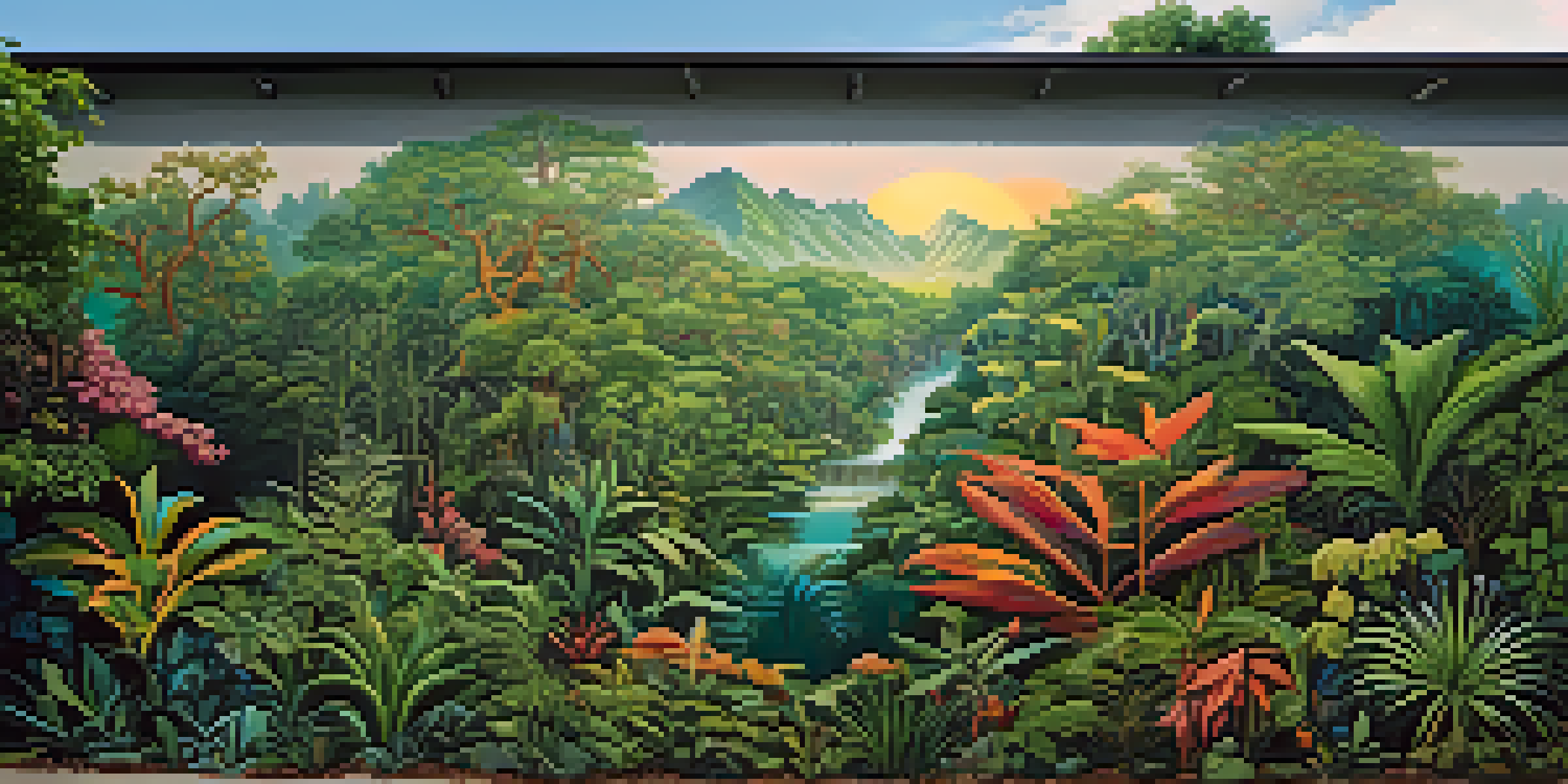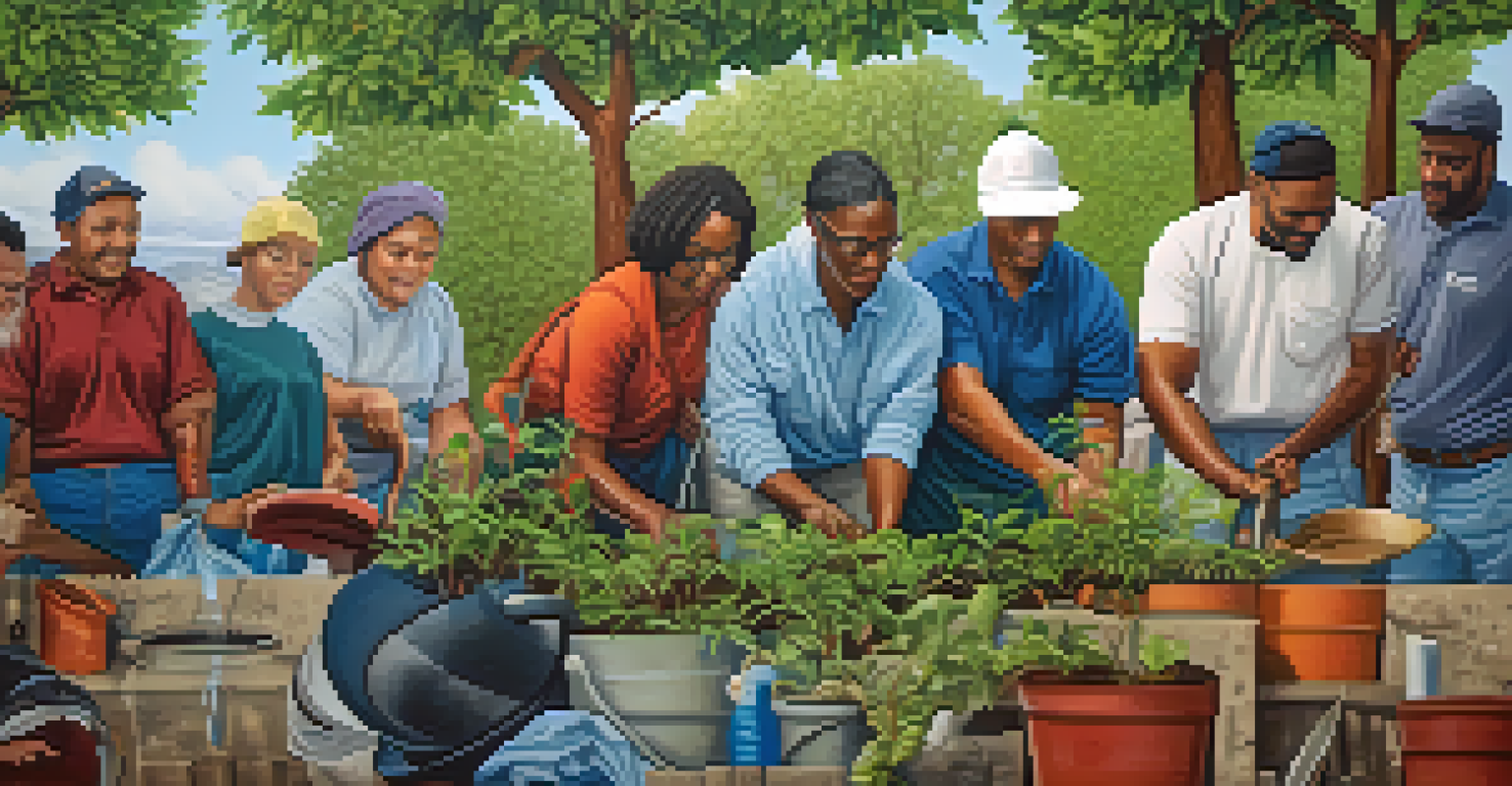Murals as a Voice for Environmental Justice and Awareness

Murals: A Canvas for Change and Expression
Murals serve as vibrant canvases that reflect the community’s voice and concerns. They transform dull walls into powerful expressions of hope, resilience, and activism. By using public spaces to showcase art, communities can communicate vital messages about environmental issues that affect them directly.
Art is not a mirror held up to reality, but a hammer with which to shape it.
For instance, in many urban areas, murals depicting polluted landscapes or endangered species resonate emotionally with passersby. This artistic representation can inspire action and awareness, fostering a deeper connection to the environment. The visual impact of art often leaves a lasting impression that mere words sometimes cannot achieve.
Moreover, by involving local artists and residents in the creation process, murals become a collaborative effort that strengthens community bonds. This unity not only amplifies the message but also encourages dialogue about environmental justice, making it a collective mission.
Highlighting Environmental Issues Through Art
Murals have the unique ability to highlight pressing environmental issues in an accessible way. They can address topics like climate change, pollution, and deforestation in a visually engaging manner. When a mural showcases the beauty of nature juxtaposed with the impacts of human activity, it prompts viewers to consider their role in these issues.

For example, a mural depicting a thriving ecosystem alongside a depiction of its degradation can evoke strong feelings of urgency. This emotional response can motivate individuals to take action, whether through community clean-ups or advocating for policy changes. Art transcends language barriers, making it a universal tool for conveying complex environmental messages.
Murals Amplify Community Voices
Murals transform public spaces into platforms for communities to express their concerns and advocate for environmental justice.
By visually narrating these stories, murals increase public awareness and prompt conversations that might not otherwise take place. This approach not only educates but also empowers communities to address environmental injustices they face.
Local Artists as Catalysts for Awareness
Local artists play a crucial role in creating murals that resonate with their community's experiences. Their intimate knowledge of local environmental challenges allows them to portray these issues authentically. By channeling their creativity into socially conscious art, they can inspire change and community engagement.
The best way to predict the future is to create it.
Many artists collaborate with environmental organizations to ensure their murals effectively communicate critical messages. This partnership can lead to projects that not only beautify neighborhoods but also provide educational opportunities about local environmental issues. For instance, an artist might work with a group focused on water conservation to create a mural that educates viewers about water scarcity.
Ultimately, these artists become advocates, using their platforms to raise awareness and drive action. Their work often sparks discussions that extend beyond the mural itself, encouraging viewers to think critically about their environmental impact.
Murals as Tools for Community Empowerment
Murals can empower communities by giving them a voice in environmental justice movements. They provide a space for marginalized voices to express their concerns and highlight injustices that may be overlooked. This form of artistic activism can lead to greater community engagement and a collective push for change.
When communities see their stories represented on public walls, it fosters a sense of pride and ownership. This ownership can motivate residents to become more active in local environmental initiatives, advocating for better policies and practices. The act of creating a mural can itself be a catalyst for community organization and collaboration.
Local Artists Drive Environmental Change
By collaborating with communities, local artists create murals that authentically portray environmental issues and inspire action.
Moreover, these artworks can attract attention from media and policymakers, amplifying the community’s message. The visibility of a mural can catalyze broader discussions about environmental justice, ensuring that these critical issues gain the recognition they deserve.
Case Studies: Inspiring Murals Around the World
Several murals around the world stand as powerful examples of art for environmental justice. One notable case is the 'Green Wall' mural in South Africa, which addresses issues of deforestation and promotes biodiversity. Such projects not only beautify urban spaces but also educate the public on local environmental challenges.
Another powerful example is the 'Mural of the Earth' in Mexico, which features indigenous flora and fauna, reminding viewers of the importance of preserving natural habitats. These murals serve as visual reminders of what is at stake and encourage community stewardship of the environment. They also highlight indigenous knowledge and practices that are vital for sustainable living.
These case studies illustrate how murals can serve as focal points for activism, igniting conversations and inspiring action on a global scale. They remind us that art can be a powerful vehicle for social change, especially in the context of environmental justice.
The Role of Technology in Mural Creation
In today’s digital age, technology plays a significant role in the creation and promotion of murals. Artists can use digital tools to design and plan their murals, ensuring that their vision is realized on the wall. This technology also allows for the incorporation of augmented reality, creating interactive experiences for viewers.
For instance, some murals can be paired with QR codes that, when scanned, provide information about the environmental issues depicted. This integration of technology not only enhances the viewing experience but also makes the message more accessible to a wider audience. It bridges the gap between traditional art and modern communication methods.
Technology Enhances Mural Impact
Digital tools and social media amplify the reach of murals, making environmental messages more accessible and engaging for audiences.
Additionally, social media platforms enable artists to share their work with a global audience, amplifying their message of environmental justice. This visibility can attract support from activists, organizations, and individuals who resonate with the message, creating a ripple effect of awareness and action.
The Future of Murals in Environmental Activism
As communities continue to confront environmental challenges, the role of murals in activism is likely to grow. These impactful artworks can serve as a rallying point for movements, uniting people around common causes. The future may see an increase in collaborative mural projects that bring together diverse voices to address environmental injustices.
Moreover, as awareness of climate change and sustainability rises, more artists may feel compelled to use their talents to advocate for the planet. We can expect to see innovative approaches to mural creation, including larger-scale projects that engage entire communities in the process. This collective effort can strengthen the message and create a deeper sense of responsibility.

Ultimately, murals will remain a vital form of expression in the fight for environmental justice. They will continue to inspire, educate, and mobilize communities, proving that art can be a powerful catalyst for change.